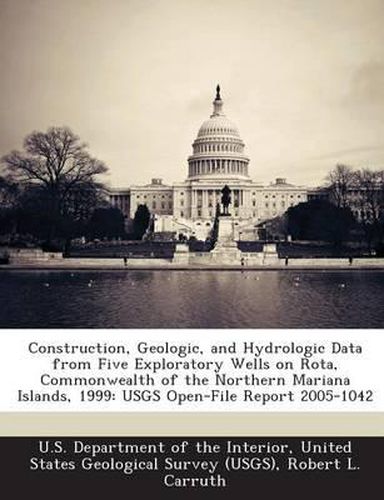Readings Newsletter
Become a Readings Member to make your shopping experience even easier.
Sign in or sign up for free!
You’re not far away from qualifying for FREE standard shipping within Australia
You’ve qualified for FREE standard shipping within Australia
The cart is loading…






Rota is the southernmost of the 14 small islands that make up the Commonwealth of the Northern Mariana Islands. Reduced springflow at Matan Hanom and As Onan springs occurred during a drought associated with the 1997-98 El Nino. Water from the two developed springs constituted the only municipal water source for the island at that time. In April 1998, reduced water supplies forced the Commonwealth Utilities Corporation to restrict water service in the principal villages of Songsong and Sinapalu for the duration of the dry season. In 1999, Five exploratory wells, EX-1 through EX-5 (CUC wells SP-MW1, SP-1, -2, -3, and SP-MW2), were drilled in the Sinapalu region of Rota to (1) assess the availability of fresh ground-water resources in an area where no other well information were available, and (2) to provide a new water source to help mitigate the impacts of drought associated with recurring El Nino weather events. The wells penetrated mainly light colored (dirty white to brownish), fragmental limestones containing abundant coral remains. Sustained-rate, recovery, and step-drawdown aquifer tests were attempted at each of the five exploratory wells to estimate aquifer properties in the vicinity of the wells and to assess the potential for new water sources. At wells EX-1 (CUC well SPMW1) and EX-5 (CUC well SP-MW2), attempts to conduct sustained-rate aquifer tests resulted in excessive drawdown to the pump intakes in the vicinity of the wells. At well EX-2 (CUC well SP-1), the maximum drawdown measured in the pumped well was 3.93 ft during 8 days of sustained pumping at an average rate of 187 gal/min. At well EX-3 (CUC well SP-2), the maximum drawdown measured in the pumped well was 2.31 ft during 8 days of sustained pumping at an average rate of 108 gal/min, and at well EX-4 (CUC well SP-3), the maximum drawdown measured in the pumped well was 3.27 ft during 8 days of sustained pumping at an average rate of 139 gal/min. Specific conductance at the end of 8 days of pumping was 403, 358, and 445 ?S/cm at well EX-2, EX-3, and EX-4 (CUC wells SP-1, -2, and -3), respectively.
$9.00 standard shipping within Australia
FREE standard shipping within Australia for orders over $100.00
Express & International shipping calculated at checkout
Stock availability can be subject to change without notice. We recommend calling the shop or contacting our online team to check availability of low stock items. Please see our Shopping Online page for more details.
Rota is the southernmost of the 14 small islands that make up the Commonwealth of the Northern Mariana Islands. Reduced springflow at Matan Hanom and As Onan springs occurred during a drought associated with the 1997-98 El Nino. Water from the two developed springs constituted the only municipal water source for the island at that time. In April 1998, reduced water supplies forced the Commonwealth Utilities Corporation to restrict water service in the principal villages of Songsong and Sinapalu for the duration of the dry season. In 1999, Five exploratory wells, EX-1 through EX-5 (CUC wells SP-MW1, SP-1, -2, -3, and SP-MW2), were drilled in the Sinapalu region of Rota to (1) assess the availability of fresh ground-water resources in an area where no other well information were available, and (2) to provide a new water source to help mitigate the impacts of drought associated with recurring El Nino weather events. The wells penetrated mainly light colored (dirty white to brownish), fragmental limestones containing abundant coral remains. Sustained-rate, recovery, and step-drawdown aquifer tests were attempted at each of the five exploratory wells to estimate aquifer properties in the vicinity of the wells and to assess the potential for new water sources. At wells EX-1 (CUC well SPMW1) and EX-5 (CUC well SP-MW2), attempts to conduct sustained-rate aquifer tests resulted in excessive drawdown to the pump intakes in the vicinity of the wells. At well EX-2 (CUC well SP-1), the maximum drawdown measured in the pumped well was 3.93 ft during 8 days of sustained pumping at an average rate of 187 gal/min. At well EX-3 (CUC well SP-2), the maximum drawdown measured in the pumped well was 2.31 ft during 8 days of sustained pumping at an average rate of 108 gal/min, and at well EX-4 (CUC well SP-3), the maximum drawdown measured in the pumped well was 3.27 ft during 8 days of sustained pumping at an average rate of 139 gal/min. Specific conductance at the end of 8 days of pumping was 403, 358, and 445 ?S/cm at well EX-2, EX-3, and EX-4 (CUC wells SP-1, -2, and -3), respectively.